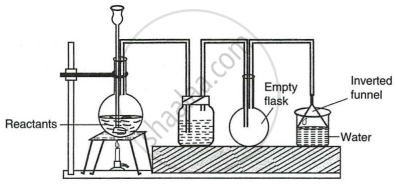Advertisements
Advertisements
प्रश्न
Explain why a solution of hydrogen chloride in water turns blue litmus red and conducts electricity, while a solution of the same gas in toluene:
- has no effect on litmus, and
- does not conduct electricity.
उत्तर
A solution of hydrogen chloride in water gives ions,
\[\ce{HCl + H2O -> H3O+ + Cl-}\]
These ions are responsible for conducting electricity and turning blue litmus red due to the presence of hydronium \[\ce{H3O+}\] ions, which cause \[\ce{HCl}\] aqueous solution to be acidic.
Toluene is an organic solvent, whereas \[\ce{HCl}\] is a covalent molecule. A solution of \[\ce{HCl}\] in toluene includes only molecules and not ions; hence, it does not conduct electricity. The absence of hydronium \[\ce{H3O+}\] ions neutralizes the solution, and it has no impact on litmus paper.
APPEARS IN
संबंधित प्रश्न
Identify the gas evolved and give the chemical test in the following cases
Dilute hydrochloric acid reacts with iron (II) sulphide.
The following are pertaining to the laboratory preparation of hydrogen chloride gas.
Name the drying agent used and justify your choice.
Write the balanced chemical equation for the laboratory preparation of hydrogen chloride gas.
Draw a labelled diagram for the laboratory preparation of hydrogen chloride gas and answer the following.
- Name the acid used. Why is this particular acid preferred to other acids?
- Give the balanced equation for the reaction.
- Name the drying agent used in drying hydrogen chloride gas.
- Phosphorous pentoxide and calcium oxide are good drying agents, but they cannot be used to dry hydrogen chloride gas. Why?
- Why is the direct absorption of \[\ce{HCl}\] gas in water not feasible?
- What arrangement is done to dissolve \[\ce{HCl}\] gas in the water?
Name the drying agents used in drying hydrogen chloride gas.
Explain why thick white fumes are formed when a glass rod dipped in \[\ce{NH4OH}\] is brought near the mouth of a bottle full of \[\ce{HCl}\] gas.
Explain why dry hydrogen chloride gas does not affect a dry strip of blue litmus paper but it turns red in the presence of a drop of water.
Explain why hydrogen chloride gas is not collected over water.
The given set up in the figure is for the preparation of an acid.

- Name the acid prepared by this method.
- Name the reactants used.
- Why an empty flask is used?
- What is the drying agent used? Why is this drying agent chosen?
- What is the role of the inverted funnel in the arrangement?
Draw a labelled diagram and explain the laboratory preparation of hydrogen chioride gas.
How will you prove that the gas prepared is HCI?
What is aqua-regia?
Mention the reaction condition and give balanced equation to obtain: Cl2 gas from HCI acid.
Complete and balance the equations:
KMnO4 + HCI → _______+ _______ + _______ + ______ + 8H2O
Write the equation for the reaction which takes place in question(a).
What property of hydrogen chloride is demonstrated when it is collected by downward delivery (upward displacement) ?
State the observation for action of dilute hydrochloiric acid or iron (II) sulphate.
One chemical test that would enable you to distinguish between the following pair of chemicals. Describe what happens with each chemical or state 'no visible reaction'.
Sodium sulphate solution and sodium chloride solution.
Give one test to distinguish between the following pair of chemicals.
Sodium nitrate solution and sodium chloride solution.
